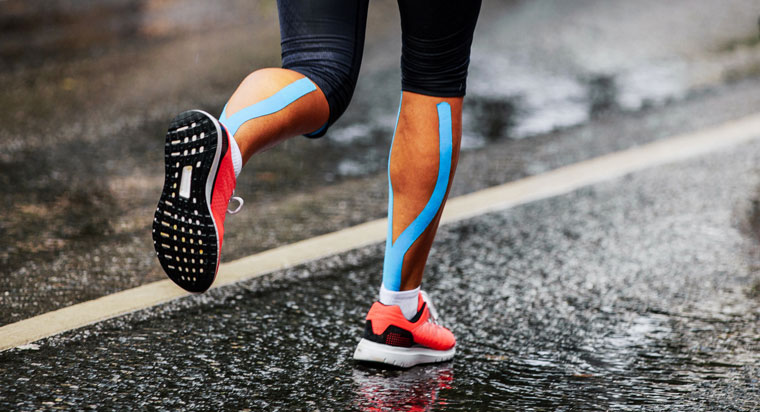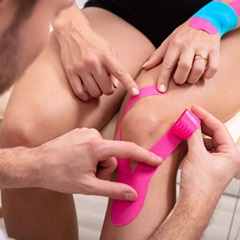How Tape Heals: The Secret Behind Kinesiology Tape

Answer a few questions and we'll provide you with a list of primary care providers that best fit your needs.
Tune in to a sports station and you’re bound to see an athlete with multi-colored tape applied on some body part, anywhere from the neck down to the feet. This tape — called kinesiology tape, or k-tape for short — is now commonly available, and its use is becoming more widespread.
But just what is it, and how does it work? Kyra Dorney, MA, LAT, ATC, a Premier Health athletic trainer, provides answers.
What Is Kinesiology Tape?
Kinesiology refers to the study of movement. Kinesio tape, as it’s often called, got its name because it is used to aid muscle movement. It’s a thin, flexible tape that is meant to relieve pain, reduce swelling and inflammation, and provide support to joints and muscles.
K-tape was originally developed as a way to enhance athletic performance. But Dorney says you don’t have to be an elite athlete to enjoy its benefits.
“I use it in the high school setting to aid in the healing process, after an athlete has an acute injury, or to relieve pain from a chronic injury,” Dorney explains. “Acute and chronic injuries can cause swelling and inflammation of the muscles and tissues of the affected area, and the use of k-tape can help alleviate pain in both types of injuries.”
K-tape was originally developed as a way to enhance athletic performance. But Dorney says you don’t have to be an elite athlete to enjoy its benefits.
How Does It Work?
According to Dorney, k-tape recruits blood vessels in a way that helps place blood flow where the tape is applied. The result is increased oxygen and decreased inflammation and swelling.
The tape can also be used to help the body’s lymphatic system drain waste products like lactic acid, which an athlete’s hard-working muscles produce. This helps muscles perform better for longer periods. In addition, k-tape slightly lifts skin, to provide extra space for swollen muscles.
How Does It Differ From Other Athletic Tape?
 Kinesio tape is not a replacement for the traditional white athletic tape that has long been used for splinting. Athletic tape is still appropriate when stability is crucial. Because it is less flexible than k-tape, athletic tape offers the support that is needed to treat certain injuries. While athletic tape often limits motion, k-tape is used to allow motion, as well as to reduce pain.
Kinesio tape is not a replacement for the traditional white athletic tape that has long been used for splinting. Athletic tape is still appropriate when stability is crucial. Because it is less flexible than k-tape, athletic tape offers the support that is needed to treat certain injuries. While athletic tape often limits motion, k-tape is used to allow motion, as well as to reduce pain.
Dorney points out that sometimes using both types of tape aids in healing an injury altogether. “K-tape may be applied first in certain acute injuries that have swelling and bruising from trauma. The k-tape will help decrease inflammation by bring blood flow to the area and get rid of some of the swelling by aiding the lymphatic system. Athletic tape could then be used to help stabilize the injury while the athlete is rehabbing back to sporting activities.”
Different brands offer different features, including elasticity, size, colors, and wear time.
Should I Try K-Tape On My Sore Muscles?
Dorney recommends people consider the following before buying their own k-tape:
- Get a diagnosis. K-tape is readily available, but don’t be too quick to go grab a roll. Chances are you are dealing with an injury or pain that may first need a diagnosis. Find out from a doctor why you have the pain in the first place. Using k-tape without a diagnosis may just mask a bigger problem allowing you to continue in an activity that your body may need rest from.
- Remember its purpose. K-tape was created to aid healing, not to create stability. Use athletic tape if you need a more secure ankle. Consider k-tape if you need to alleviate pain from an arthritic knee.
- Create a limit. Don’t continue to tape or engage in activity for more than a couple of days. Pain that persists should be evaluated immediately.
Is There Proof That K-Tape Works?
Dorney has seen her athletes recover from acute injuries more quickly since using Kinesio tape. “When we’re able to aid the initial healing process of an acute injury, and also provide pain relief and corrections for chronic injuries, the athletes tend to return to their sport faster and with minimal discomfort.”
Several research studies have been published on the use of this therapeutic tape for various types of treatments. It has been studied in the treatment of musculoskeletal injuries, breast cancer-related lymphedema, balance ability in stroke patients, and more. Results have been varied. Most studies conclude that further investigation is needed.
Answer a few questions and we'll provide you with a list of primary care providers that best fit your needs.
Sources: Kyra Dorney, MA, LAT, ATC, Staff Athletic Trainer, Premier Health; Sports-health




